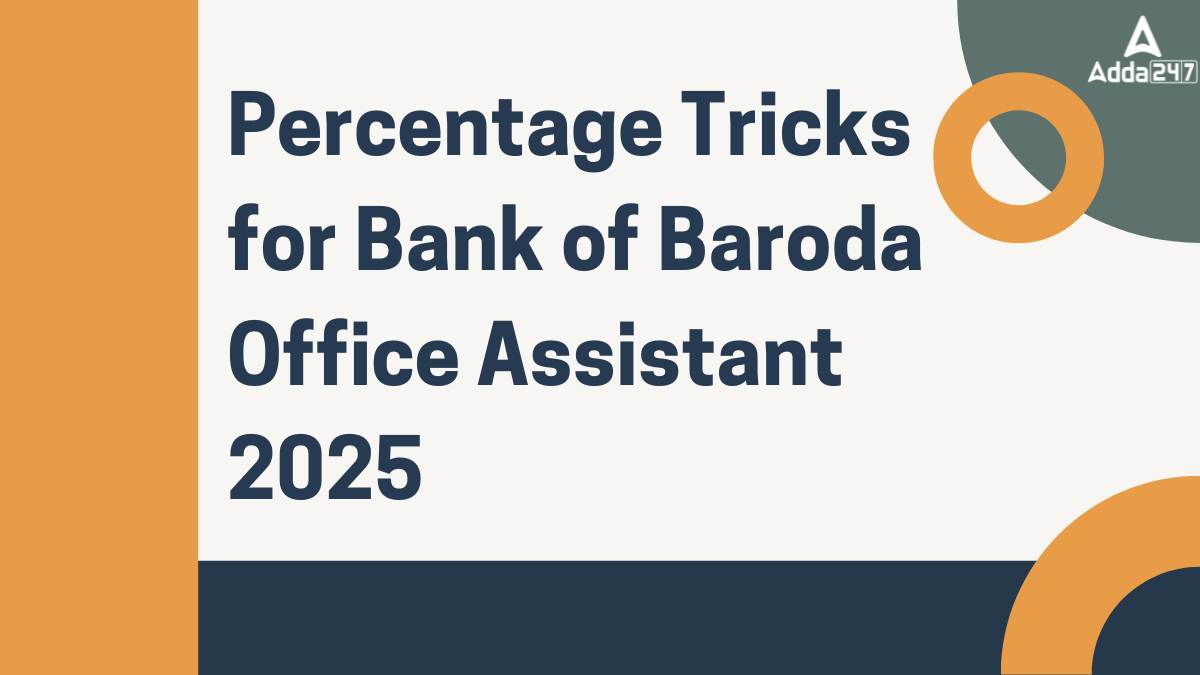The Bank of Baroda Office Assistant examination, like many other competitive banking exams, places a significant emphasis on Arithmetic. Among the various topics tested, percentages stand out as a fundamental concept, not only for direct percentage-based questions but also as an underlying principle for other crucial areas such as Profit & Loss, Simple and Compound Interest, Data Interpretation and Ratio & Proportion. For aspiring candidates aiming to secure a position in 2025, mastering percentage calculations with speed and accuracy is not merely an advantage, but a necessity.
Percentage for Bank of Baroda Office Assistant 2025
At its core, a percentage is a way of expressing a number as a fraction of 100. The term “percent” literally means “per hundred.” Understanding this basic definition is crucial before moving on to advanced tricks. For instance, 25% means 25 out of 100, which can be written as the fraction 25/100 or the decimal 0.25. The first and most vital trick is to memorise common percentage-to-fraction equivalents. This seemingly simple step can save invaluable time during the Bank of Baroda Recruitment 2025 exam.
Percentage Calculation Tricks
Once the basic conversions are internalized, several operational tricks can be applied:
1. The “10% and 1%” Rule: This is arguably the most versatile trick for calculating percentages of any number. To find 10 of a number, simply move the decimal one place to the left. To find 1 of a number, move the decimal two places to the left.
Example: Calculate 37 of 500.
10 of 500=50
1 of 500=5
30 of 500=3×50=150
7 of 500=7×5=35
37 of 500=150+35=185.
This method allows for breaking down any percentage into manageable parts, especially useful for percentages that are not standard fractions.
2. Breaking Down Percentages: Similar to the above, complex percentages can be broken into sums or differences of easier percentages.
Example: Calculate 85 of 400.
85
100 of 400=400
10 of 400=40
5 of 400=20 (half of 10)
15 of 400=40+20=60
85 of 400=400−60=340.
3. The “A% of B = B% of A” Principle: This trick is a lifesaver for calculations involving awkward numbers. The order of the percentage and the number can be swapped.
Example: Calculate 16% of 25.
This can be rewritten as 25% of 16.
Since 25%, 1/4 of 16=4.
This is much simpler than calculating 16 of 25 directly.
Percentage to Fraction
Conversion of Percentage to Fraction makes the calculation faster, so memorising it becomes essential. Here is the table below that contains important percentage-to-fraction conversions.
| Percentage | Fraction |
| 1% | 1/100 |
| 2% | 1/50 |
| 4% | 1/25 |
| 5% | 1/20 |
| 10% | 1/10 |
| 12.5% | 1/8 |
| 16.67% | 1/6 |
| 20% | 1/5 |
| 25% | 1/4 |
| 33.33% | 1/3 |
| 50% | 1/2 |
| 66.67% | 2/3 |
| 75% | 3/4 |
| 80% | 4/5 |
| 90% | 9/10 |
Tricks for Percentage Increase/Decrease and Net Change
These are crucial for Profit & Loss and Compound Interest problems.
Percentage Increase/Decrease as a Multiplication Factor:
- If a value increases by X, the new value is the original value multiplied by (1+X/100).
- If a value decreases by X, the new value is the original value multiplied by (1−X/100).
- Example: A price of ₹200 increases by 15%. New price = 200×(1+15/100) = 200×1.15=₹230.
- This method is highly efficient for single changes.
Net Percentage Change for Successive Changes (A-B Formula): When a quantity undergoes two successive percentage changes, say an increase of A and then an increase of B, the net percentage change is given by:
Net Change =(A+B+ AB/100)
- Important Note: If there’s a decrease, the corresponding percentage value is taken as negative.
- Example: A shirt’s price is increased by 20 and then decreased by 10. A=+20, B=−10. Net Change =(20+(−10)+ (20×(-10))/100). Net Change =(10− 200/100) increased
- This formula is invaluable for problems involving multiple discounts or successive profit/loss percentages.
Application of Percentage in Bthe ank of Baroda Office Assistant Exam
These tricks are not just theoretical; their true value lies in their application across various question types:
- Data Interpretation (DI): DI sets frequently involve calculating percentages of large numbers, percentage increases/decreases over years, and percentage comparisons. Rapid percentage calculation is the backbone of scoring well in DI.
- Simplification/Approximation: Many questions in this section are designed to test quick mental calculations involving percentages. Using the 10 and 1 rule or fraction equivalents can significantly reduce calculation time.
- Word Problems: Problems on Profit & Loss, Simple Interest, Compound Interest, and even Ratio & Proportion often boil down to percentage calculations. Applying these tricks makes solving complex word problems much faster.
Practice of Percentage
Merely knowing these tricks is not enough; consistent practice is paramount. Candidates should:
- Practice Daily: Dedicate specific time each day to practice percentage problems.
- Solve Previous Year Papers: Analyze past Bank of Baroda Office Assistant papers to understand the types of percentage questions asked and their difficulty level.
- Take Mock Tests: Regularly attempt full-length mock tests under timed conditions to simulate the actual exam environment and identify areas for further improvement.
- Focus on Mental Math: Try to perform calculations mentally as much as possible, reducing reliance on pen and paper.
- Review and Analyze: After solving problems, review your approach. If you took too long, identify where you could have applied a trick more effectively.




 Number Series Questions for Bank Exams
Number Series Questions for Bank Exams
 Most Important Approximation Questions f...
Most Important Approximation Questions f...
 Quadratic Equation Questions for SBI PO ...
Quadratic Equation Questions for SBI PO ...








